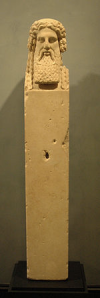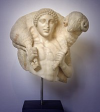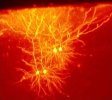I know this is an old thread but rather then start a new one I thought it would fit to post here.
For the past 8 days, I spent my time researching the etymology and meaning of my first and last name which I posted
here. The beginning of my last name means cock/rooster and during my research I ran into a lot of other references to the cock which I'd like to share. It's not really that much and perhaps a lot of this is already known. Never-the-less, I'll start with this:
Etymology of Rooster:
Roost: late Old English hrost "wooden framework of a roof, perch for domestic fowl," from Proto-Germanic *hro(d)-st- (source also of Old Saxon hrost "framework of a roof, attic," Middle Dutch, Flemish, Dutch roest "roost," Old Norse hrot, Gothic hrot "roof," of unknown origin. Exact relationship and ulterior connections unknown. Extended sense "hen-house" is from 1580s. To rule the roost is recorded from 1769. (
LINK)
Rooster: 1772, agent noun from roost (v.); earlier roost cock, c. 1600, in sense of "the roosting bird." Favored in the U.S. originally as a puritan alternative to cock (n.) after it had acquired the secondary sense "penis" (and compare roach). (
LINK)
Cock (1): “male of the domestic fowl," from Old English cocc "male bird," Old French coc (12c., Modern French coq), Old Norse kokkr, all of echoic origin. Compare Albanian kokosh "cock," Greek kikkos, Sanskrit kukkuta, Malay kukuk. "Though at home in English and French, not the general name either in Teutonic or Romanic; the latter has derivatives of L. gallus, the former of OTeut. *hanon-" [OED]; compare hen.
Cock (3): The male of the domestic fowl (along with the bull) has been associated in many lands since ancient times with male vigor and especially the membrum virile, but the exact connection is not clear (the cock actually has no penis) unless it be his role as fertilizer of the domestic hens, and there may be some influence from cock (n.2) in the "tap" sense. (
LINK)
Hen: "the female of the domestic fowl," Old English henn "hen," from West Germanic *hannjo (source also of Old Frisian henn, Middle Dutch henne, Old High German henna), fem. of *hanan- "male fowl, cock" (source of Old English hana "cock"), literally "bird who sings (for sunrise)," from PIE root *kan- "to sing.”
The original masculine word survives in German (Hahn "cock"), Swedish, Danish, etc. German also has a generic form, Huhn, for either gender of the bird. Extension to "female of any bird species" is early 14c. in English. (
LINK)
Chicken: Old English cicen (plural cicenu) "young of the domestic hen, the young of any bird;" by early Middle English, "any chicken," regardless of age, from Proto-Germanic *kiukinam (source also of Middle Dutch kiekijen, Dutch kieken, Old Norse kjuklingr, Swedish kyckling, German Küken "chicken"), from root *keuk- (echoic of the bird's sound and possibly also the root of cock (n.1)) + diminutive suffixes. By regular sound changes it should have become Modern English *chichen; the reason it didn't is unknown.
Generic words for "chicken" in Indo-European tend to be extended uses of "hen" words, as hens are more numerous than cocks among domestic fowl, but occasionally they are from words for the young, as in English and in Latin (pullus). Meaning "one who is cowardly or timorous" is from 1610s; adjectival sense of "cowardly" is at least as old as 14c. (compare hen-herte "a chicken-hearted person," mid-15c.). As the name of a game of danger to test courage, it is first recorded 1953. (
LINK)
----------------------------------------------------------------------------------------------------------------------------------------------------------
From the '
Cultural References to Chickens' wiki (which has a lot of stuff) here's just two different views:
Zoroastrianism, claimed to be "the oldest of the revealed world-religions" and founded by the Prophet Zoroaster (or Zarathustra) opposed animal sacrifices but held the rooster as a "symbol of light" and associated the cock with "good against evil" because of his heraldic actions. In Iran during the Kianian Period, from about 2000 B.C. to about 700 B.C., among domestic birds, "the cock was the most sacred" and within that religion, the devout, "had a cock to guard him and ward off evil spirits".
In the sixth century, it is reputed that Pope Gregory I declared the cock the emblem of Christianity saying the rooster was "the most suitable emblem of Christianity", being "the emblem of St Peter". Some say that it was as a result of this that the cock began to be used as a weather vane on church steeples, and some a Papal enactment of the ninth century ordered the figure of the cock to be placed on every church steeple.
The "emblem of St. Peter" is derived from the "
Denial of Peter":
Following the arrest of Jesus, Peter denied knowing him three times, but after the third denial, he heard the rooster crow and recalled the prediction as Jesus turned to look at him. Peter then began to cry bitterly. This final incident is known as the Repentance of Peter.
----------------------------------------------------------------------------------------------------------------------------------------------------------
@Kisito: In relation to your dream, you might find #2 interesting.
What is the position of rooster in Zoroastrian religion? (LINK)
1. In the Avesta, the rooster is known as paro-darsh, which literally means “he who foresees the coming dawn.” Its main function is to crow at dawn to scare away Bushyãsta, the demon of sloth and laziness.
2. While the demon Bushyãsta makes people drowsy and puts them to sleep, the rooster wakes up people by crowing. While crowing at dawn it seems to say “Oh men! Wake up. Sleeping for long is not good for you.” However, lazy people do not appreciate the rooster waking them up. So they rebuke it by calling it Kahrkatas “a croaker.”
3. Being an opponent of an evil being, a rooster naturally becomes an ally of the good divine forces of the Universe. It has a special connection to Sarosh Yazad. It is said to be the keenest and most faithful follower of Sarosh Yazad, and is considered one of his closest allies.
4. It is believed that the rooster protects the world from the evils of Zohak, who is bound under the Demavand mountain [
*my note: by King Faredoon] and is waiting to unleash his evils on the world by trying to free himself. Tradition has it that throughout the night Zohak tries to free himself by licking at his chains making them thin, but as they are about to snap, dawn draws near, and the crowing of the rooster foils his attempts to escape and his chains resume their thickness. Actually the crowing of the rooster indicates the rising of the sun, and it is the good energy of the sun that neutralises the strength of evil collected during the night.
5. Another oral tradition associated with the rooster in Parsi culture is that one should not eat a rooster, the reason being that it is a representative of Sarosh Yazad and an opponent of Bushyāst dev.
6. The rooster is highly regarded at the Pier-e-Banu Pars in Yazd, Iran. When princess Banu Pars was fleeing the Arabs, night came on, and the exhausted princess went to sleep on the mountains. In the morning, the tired Banu Pars was not able to wake up and the pursuing Arabs came close to her. It was at that time that the rooster crowed and woke her up, and she was able to escape the clutches of the Arabs.
----------------------------------------------------------------------------------------------------------------------------------------------------------
Point #4 above made me think of this discussion with the C's from
19 July, 1997:
Q: Okay. Change gears: Why is the rooster, or the crowing of the rooster, associated with the idea of underground cities, civilizations, or bases?
A: What causes the rooster to crow?
Q: Light. But, how is light related to an underground city?
A: Tis not just light, but the emergence of light from the depths of the darkness.
Q: Are there such things as 'DEROS,' as described in this underground bases book?
A: Detrimental Robots.
Q: Are DEROS part of the underground city/bases scenario?
A: Yup.
----------------------------------------------------------------------------------------------------------------------------------------------------------
While running through an
Old English dictionary for the words cock/rooster I came across a very interesting and solitary word that popped up in the results list for 'hana' (rooster): the word ‘hán’ which means ‘(boundary-) stone’.
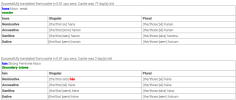
Now I actually thought that this was a very interesting meaning. And later on, I found this from the
Orion wiki:
“The Babylonian star catalogues of the Late Bronze Age name Orion MULSIPA.ZI.AN.NA, "The Heavenly Shepherd" or "True Shepherd of Anu" – Anu being the chief god of the heavenly realms. The Babylonian constellation is sacred to Papshukal and Ninshubur, both minor gods fulfilling the role of 'messenger to the gods'. Papshukal is closely associated with the figure of a walking bird on Babylonian boundary stones, and on the star map the figure of the Rooster is located below and behind the figure of the True Shepherd—both constellations represent the herald of the gods, in his bird and human forms respectively.” (Babylonian Star-lore by Gavin White, Solaria Pubs, 2008, page 218ff & 170)
In the "Prehistoric Astronomy and the Younger Dryas Catastrophe?"
thread,
@Michael B-C posts the star map that Gavin White recreated. In the map you can see the rooster and the "True Shepherd" at the 4 o'clock position.
Now, I'm just gonna float this idea with a lot of helium: the thought occurred to me if the god Papshukal and Sarosh Yazad (from Zoroaster #3 above) might not be the same 'god'?
----------------------------------------------------------------------------------------------------------------------------------------------------------
Much is made about the Greek god of medicine Asclepius (son of Apollo and Coronis) and his staff with the snake coiled around it. There are two other animals that are apparently associated with Asclepius, if you didn’t already know. (
LINK):
“Additionally, he was also said to be associated with dogs (Cartwright, 2013). Lastly, and less commonly noted, there was also been mention of relations to the cock in some writings (Lagasse, 2017).”
“According to Risse (1999), cockerels were identified with dawn. The cock is allegedly the animal that spans darkness and light and accordingly, day and night (Tick, 2001).”
----------------------------------------------------------------------------------------------------------------------------------------------------------
There is the Gnostic deity(?)
Abraxas. I haven't read much about it and so I'm not sure what to think.
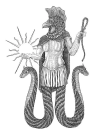
----------------------------------------------------------------------------------------------------------------------------------------------------------
The idea of the word ‘cock’ taking on a vulgar meaning in the 17th-18th centuries and it's subsequent replacement word 'rooster' has a vague history. My thoughts on how it happened have something to do with the spur, or cockspur… oh, excuse me, rooster spur.

I’ve been looking for a 15th/16th+ century book with an illustration showing the anatomy of a rooster with Latin words thinking that that might shed some light on the matter but I have not been able to find one. Perhaps the image might give you an idea of my line of thought. But for now, I only have a Latin word: ‘calcar: spur of a cock’.
----------------------------------------------------------------------------------------------------------------------------------------------------------
Finally, I'll finish with a fun tail attributed to Aesop that is derived from an older tail.
The Cock and the Fox
A fox was trotting past a farmyard early one morning when when he heard a cock crowing. Upon investigation he found that chanticleer was perched in a tall tree far out of reach of anyone who might be entertaining thoughts of having him for breakfast.
"Why, cousin cock," the fox called up to the bird in the tall tree, "what a pleasure it is to see you! Won't you come down and let me greet you properly?”
"I would love to ," replied the cock (who was no fool), "but, as you know, there are some animals who would like nothing better than to grab me and eat me.”
"Why, my dear cousin," exclaimed the fox, "do you mean to say you haven't heard the news? All the animals have agreed to live in peace with one another.”
While the fox was speaking, the cock kept craning his neck as though he could see something very interesting in the distance. Naturally, the fox was consumed with curiosity.
”Cousin, what in the world do you see up there that is so interesting?”
"Oh, nothing much- just a pack of hounds headed in this direction and coming at a fast clip," said the cock.
"Please excuse me," said the fox nervously. "I just thought of something I had forgotten.”
"What's the hurry?" asked the cock. "I was just coming down for a talk. You don't mean to say that you have anything to be afraid of now that you know about the wonderful peace plan?”
"Well," replied that fox, as he started to run, "maybe those hounds haven't heard about it yet!
("Aesop's Fables" (Illustrated Junior Library)- Illustrated by Fritz Kredel- Grosset & Dunlap, Inc.- 1949)
Cook-a-doodle-do






